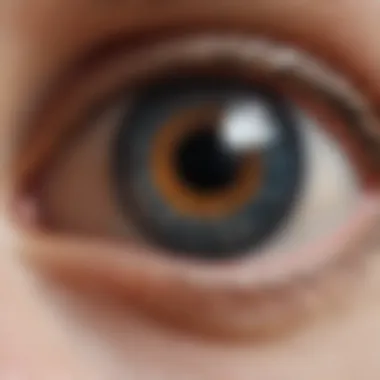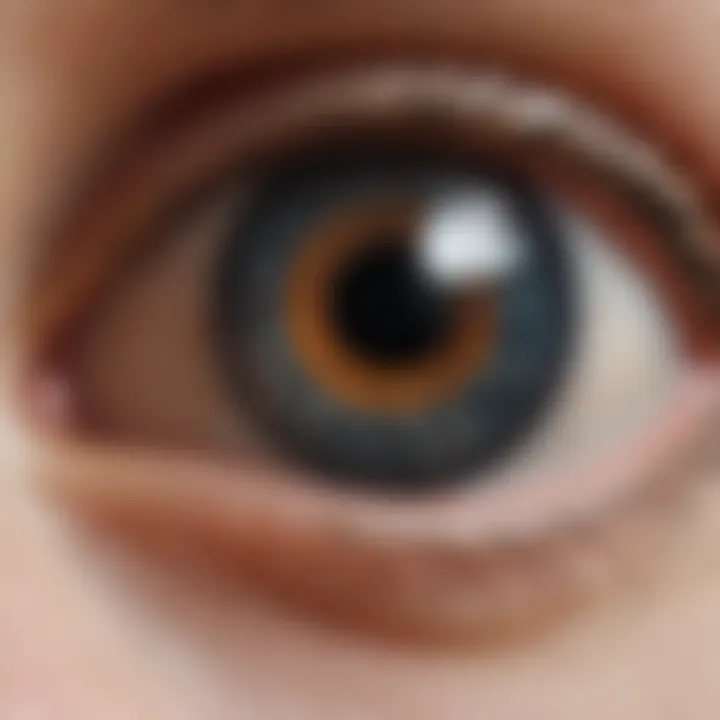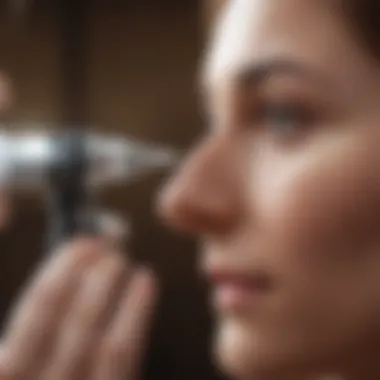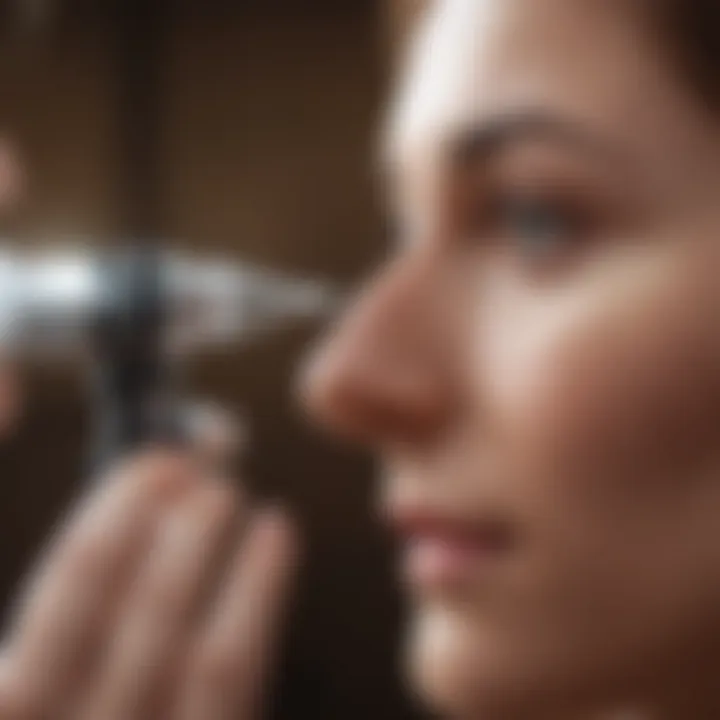Understanding Eye Ointment for Corneal Abrasion Treatment


Intro
Corneal abrasion is a common eye injury characterized by scratches on the cornea, the transparent front part of the eye. This condition can result from various factors, such as foreign bodies, contact lens use, or trauma. Understanding how to manage this issue is crucial, not only to mitigate discomfort but also to prevent complications involving vision. Eye ointments specifically designed for corneal abrasions play a significant role in the recovery process. This article aims to explore the effectiveness, appropriate use, and various types of eye ointments available in the market.
Research Overview
Summary of Key Findings
The application of eye ointments has shown to promote faster healing rates for corneal abrasions. Ointments often contain antimicrobial agents and therapeutic solutions that reduce the risk of infection and inflammation. Consultation with healthcare professionals is essential to determine the correct treatment, as not all ointments are suitable for every patient. Moreover, side effects can arise from improper use or allergies to specific ingredients.
Background and Context
Corneal abrasions are prevalent among individuals of all ages. The symptoms usually encompass redness, tearing, blurred vision, and discomfort. Timely application of eye ointments can significantly relieve these symptoms and stimulate healing. Knowledge of the types of available eye ointments, their ingredients, and their modes of action is vital for effective treatment. Understanding the critical components can empower patients and caregivers to make informed decisions regarding eye care.
Types of Eye Ointments
Different eye ointments come with varying ingredients. It is essential to distinguish between these types to choose the most appropriate option. Common categories include:
- Antibiotic Ointments: Prevent bacterial infections, essential for cases involving potential contamination.
- Moisturizing Ointments: Facilitate healing by providing essential moisture to the dry and damaged cornea.
- Steroid Ointments: These reduce inflammation but require careful use to avoid adverse effects like increased eye pressure.
Each category serves a distinct purpose. The right choice often depends on the severity and specific nature of the abrasion.
Proper knowledge about eye ointments can ensure effective treatment and speedy recovery.
Prelude to Corneal Abrasion
Understanding corneal abrasion is crucial as it highlights a common yet often overlooked issue affecting eye health. Corneal abrasions, which refer to scratches on the cornea, can lead to significant discomfort and, if untreated, may result in complications such as infections or vision loss. This section emphasizes the underlying importance of recognizing symptoms and seeking early intervention to mitigate adverse effects.
Definition and Overview
A corneal abrasion is a superficial injury to the clear front surface of the eye, known as the cornea. The cornea is responsible for light refraction, which is essential for vision. An abrasion might occur due to various causes, such as foreign objects, contact lenses, or accidental injuries. The severity of a corneal abrasion is often classified as superficial and can affect only the outer layer of the cornea, the epithelium. Understanding the definition and characteristics of corneal abrasions facilitates better recognition of their occurrence during regular eye care assessments and daily life.
Causes of Corneal Abrasions
Corneal abrasions can arise from numerous factors. Common causes include:
- Foreign Bodies: Small particles like dust, sand, or metal can scratch the cornea.
- Contact Lenses: Improper use of contact lenses or sleeping with them may cause abrasions.
- Injury or Trauma: Accidental bumps or scratches can result from various activities.
- Chemical Exposure: Certain chemicals may irritate and damage the cornea, leading to abrasions.
Awareness of these causes is necessary for implementing preventive measures. Identifying risk factors can aid individuals in making informed choices about their eye care routines.
Symptoms and Diagnosis
Symptoms of a corneal abrasion typically include:
- Severe pain or discomfort in the eye.
- A sensation of something being in the eye (foreign body sensation).
- Redness of the eye and surrounding area.
- Excessive tearing or discharge.
- Light sensitivity (photophobia).
Diagnosis usually involves a comprehensive eye examination. An eye care professional may use a fluorescein dye test to detect the abrasion's presence. This test will illuminate the affected area when viewed with a special light, making it easier to assess the severity and extent of the damage. Prompt diagnosis is crucial as it enables effective treatment, reducing potential complications.


Role of Eye Ointments in Treatment
Eye ointments play a significant role in the management of corneal abrasions. These abrasions, though often not severe, can cause noticeable pain and discomfort. Proper treatment is necessary to facilitate healing and avoid complications. Eye ointments serve as both therapeutic agents and protective barriers during the recovery phase. Their application can help reduce the risk of infection and alleviate discomfort associated with the abrasion.
Mechanisms of Action
Eye ointments work through various mechanisms to support healing. Primarily, they provide a protective layer over the cornea. This acts like a shield against irritants in the environment. They prevent further damage from blinking or exposure to air, which can worsen the abrasion.
In addition, many eye ointments contain active ingredients tailored to promote healing. For instance, antibiotic ointments help to eliminate potential bacterial infections, which can develop at the site of the abrasion. Similarly, antifungal or antiviral components target possible fungal or viral pathogens that may complicate the healing process. The moist environment created by these ointments can also enhance epithelial cell regeneration, leading to faster recovery of the corneal surface.
Common Ingredients in Eye Ointments
The effectiveness of eye ointments can depend greatly on their formulation. Key ingredients commonly found in eye ointments include:
- Antibiotics: Such as neomycin or bacitracin, to prevent or treat infections.
- Antifungals: Like clotrimazole, which can be critical for fungal infections.
- Lubricants: Ingredients like mineral oil or lanolin help maintain moisture in the eyes.
- Preservatives: These are used to extend shelf life but must be considered carefully, as some individuals may have sensitivities.
The selection of an appropriate ointment is crucial for addressing the unique aspects of each case. It’s important to utilize formulations that suit the specific type of corneal abrasion.
Importance of Lubrication
Lubrication is vital in the treatment of corneal abrasions. The cornea’s surface must remain adequately lubricated to promote healing and prevent further irritation. Eye ointments provide a more prolonged lubricating effect compared to drops. This extended contact time is especially beneficial during the night or in individuals who have difficulty keeping their eyes closed, as it helps maintain hydration on the eye's surface.
In summary, the role of eye ointments in treating corneal abrasions is multifaceted. From their mechanisms of action to the importance of lubrication, understanding these elements is crucial. Proper usage can significantly contribute to minimizing discomfort and supporting the healing process.
Types of Eye Ointments
Eye ointments play a crucial role in the treatment of corneal abrasions by providing targeted relief and promoting healing. Different types of eye ointments are designed for specific situations and vary by their active ingredients. Understanding the options available is important for effective treatment. Here are some types:
Antibiotic Ointments
Antibiotic ointments are specifically formulated to prevent or treat bacterial infections that may arise from a corneal abrasion. These products include ingredients such as bacitracin and polysporin, which help to eliminate harmful bacteria while protecting the affected area.
Utilization of antibiotic ointments is vital in cases where the cornea is exposed to environmental pathogens. They help to form a barrier against potential infections. Effective application can lead to faster healing and lower risks of complications.
It's worth noting that antibiotic ointments are generally not effective against viral or fungal infections. Thus, accurate diagnosis of the type of infection is important; healthcare professionals often determine when these should be used.
Antiviral or Antifungal Ointments
For abrasions caused by viral or fungal infections, antiviral or antifungal ointments are appropriate choices. For instance, acyclovir is a commonly prescribed antiviral medication used to prevent herpes simplex infections. Meanwhile, natamycin is often used as an antifungal treatment.
Using these ointments correctly can speed up recovery and mitigate the risk of further complications. However, they should only be used under the guidance of a healthcare professional to ensure they are appropriate for the type of infection.
Moisturizing and Lubricating Ointments
Moisturizing and lubricating ointments are designed to alleviate discomfort caused by dry eyes and to provide a moisture-rich environment for healing. Ingredients like carbomer and hyaluronic acid are common in these formulations. They help maintain moisture and minimize irritation.
These ointments are particularly useful for patients who experience significant dryness that can occur as a result of corneal abrasions. Consistent use of moisturizing products can be crucial in ensuring the comfort of the patient and hindering any further damage to the eye surface.
Usage Guidelines for Eye Ointments


Usage guidelines for eye ointments are critical for effective treatment of corneal abrasions. These guidelines inform patients and practitioners alike on the proper way to use these medications, ensuring that the ointments work as intended. Misuse or poor adherence can lead to insufficient healing, increased discomfort, or even complications that could arise from untreated abrasions. Therefore, an understanding of dosage, frequency, and duration of treatment is essential for optimal patient outcomes.
Dosage and Administration
The correct dosage of eye ointments varies depending on the specific product and the severity of the corneal abrasion. Typically, small amounts are sufficient since ointments are more concentrated compared to drops. Practitioners often recommend a pea-sized amount for each application. It's crucial to avoid touching the tip of the ointment tube to the infected or injured eye to prevent further contamination. Patients should consult their healthcare provider for detailed instructions tailored to their condition, ensuring that the treatment is as effective as possible.
Frequency of Application
The frequency of applying eye ointments generally ranges from one to four times a day. For acute cases, more frequent applications may be necessary to keep the eye lubricated and promote healing. Understanding the need for regular applications also acknowledges that each application helps alleviate discomfort and protects the cornea from additional injuries. In some cases, while patients may feel relief, it is important not to reduce the frequency of applications without consulting a healthcare professional. Regularity in usage ensures consistent benefits from the ointment.
Duration of Treatment
The duration for which eye ointments should be used can differ based on the individual's recovery progress. Most corneal abrasions heal within a few days. However, patients should not discontinue using the ointment prematurely, as doing so might hinder complete healing. Follow-up appointments with a healthcare provider are important to evaluate the healing process. Regular assessments ensure that if complications arise, they are addressed promptly. Following the recommended duration maximizes the healing benefits while reducing the risk of potential complications.
Clear understanding of dosage, frequency, and duration can significantly improve recovery outcomes for those suffering from corneal abrasions.
Potential Side Effects
The discussion about potential side effects of eye ointments is essential in the context of treating corneal abrasions. Understanding these risks can significantly enhance patient safety and comfort. Each type of eye ointment can produce adverse reactions that range from mild irritations to severe allergic responses. This section aims to elucidate these potential side effects, providing an informed perspective on their implications.
Common Adverse Reactions
Common adverse reactions to eye ointments often include symptoms like burning or stinging upon application, redness, and temporary blurred vision. These effects are usually mild and are expected to subside quickly. Most patients find that the discomfort diminishes with continued use as their eyes become accustomed to the medication.
In some cases, patients might experience more serious reactions:
- Dryness or stinging: Often occurs as an initial response when the ointment is first applied.
- Increased sensitivity: Some may feel heightened sensitivity to light.
- Visual disturbances: These can happen particularly when ointments are applied just before activities that require clear vision.
Understanding the likelihood of these reactions is critical, as it allows for a more comfortable treatment experience.
Allergic Reactions
Allergic reactions to eye ointments, while infrequent, can pose more considerable challenges. Signs of an allergic response might include swelling of the eyelids, rash around the eye, and increased tearing. In rare instances, a serious allergic reaction known as angioedema may occur, causing swelling deep within the skin tissue.
Patients should be aware of the following signs:
- Itching or burning: Excessive discomfort that does not resolve after application.
- Swelling: Noticeable changes in the surrounding areas of the eye.
- Difficulty breathing: A critical sign that requires immediate medical attention.
Recognizing these symptoms early is vital to avoiding severe complications.
Recommendations for Managing Side Effects
Effective management of side effects is crucial for maintaining adherence to treatment. Here are several strategies that patients can employ:
- Proper Application: Ensure that the ointment is applied according to the healthcare provider's instructions. This reduces unnecessary exposure to the medication.
- Pre-application Testing: Consider testing a small amount of ointment on the inner arm to check for potential sensitivities.
- Consultation: Always discuss any reactions experienced with a healthcare professional. They may adjust dosage or switch to a different formulation.
- Use of Artificial Tears: Lubricating eye drops can help alleviate dryness or irritation caused by the ointment.
"Do not ignore any unusual symptoms after using an eye ointment. Alert your healthcare provider as soon as possible."
In summary, being aware of potential side effects associated with eye ointments for corneal abrasion is essential. This knowledge empowers patients to take charge of their treatment, ensuring both safety and effectiveness.


Consultation with Healthcare Professionals
Consultation with healthcare professionals plays a crucial role in managing corneal abrasion. The symptoms of this condition, although clear, can sometimes overlap with other ocular issues. Thus, a comprehensive assessment from an eye specialist helps ensure that the correct treatment is initiated promptly. Moreover, professional assessments can detect complications that may not be visible to the untrained eye, such as infections or deeper injuries to the cornea.
Importance of Professional Guidance
Seeking professional guidance offers several key benefits. Firstly, healthcare professionals can accurately diagnose the specific type of corneal abrasion and recommend the most suitable eye ointment. This personalized approach minimizes the risk of complications and enhances the healing process.
Additionally, professionals provide tailored instructions on how to properly use eye ointments, including dosing and limiting exposure to irritants. Misuse of ointments can lead to inadequate treatment, prolonging discomfort or resulting in severe complications. For individuals managing additional health concerns, such as allergies or concurrent medications, expert advice can also guide appropriate choices that consider all aspects of a patient’s health.
When to Seek Medical Attention
It is essential for individuals to know when to seek medical attention. Generally, medical care should be pursued in the following scenarios:
- Experiencing severe pain: Mild discomfort is common, but intense pain can indicate a more serious injury.
- Vision changes: Any changes in vision or the inability to see clearly merit immediate evaluation.
- Signs of infection: Symptoms like increased redness, swelling, discharge from the eye, or persistent tearing should be assessed by a healthcare professional.
- Lack of improvement: If symptoms do not improve after initial treatment with over-the-counter options or prescribed ointments, further investigation is necessary.
- Presence of foreign objects: If a foreign body is suspected in the eye, professional assessment is vital to avoid further damage.
In any case where there is doubt, it is prudent to consult with an eye care provider.
"Prompt professional evaluation can prevent complications and ensure healing while reducing the overall recovery time."
Understanding when and how to reach out to healthcare professionals can make the difference between a quick recovery and prolonged discomfort. Individuals should prioritize their eye health by being aware of these parameters.
Alternative Treatments for Corneal Abrasions
Exploring alternative treatments for corneal abrasions is crucial for individuals seeking comprehensive healing strategies. While eye ointments play a significant role, there exist additional options worth considering. These alternatives can serve not only during treatment but also for prevention and recovery. Understanding these methods enhances an overall approach to managing corneal abrasions.
Other Pharmaceutical Options
Several pharmaceutical treatments are available besides eye ointments. For instance, antibiotic drops are often prescribed to prevent or treat infections. Drops like tobramycin and ciprofloxacin can help eliminate bacteria from the surface of the eye. Others might include non-steroidal anti-inflammatory drugs (NSAIDs), providing relief from pain and reducing inflammation.
It is essential to follow the specific recommendations of a healthcare professional regarding dosage and frequency. Likewise, it is critical to be aware of any potential side effects linked with these medications, such as stinging or allergic reactions.
Home Remedies and Preventive Measures
Home remedies can offer additional comfort and promote healing. One common method involves using cold compresses. Gently applying a clean, cold cloth can alleviate discomfort and reduce swelling. Another option is using artificial tears, which provide lubrication and help protect the cornea. Over-the-counter products are widely available and can be used to maintain moisture levels.
Preventive measures are vital as well. Wearing protective eyewear can significantly reduce the risk of future abrasions, especially in hazardous environments or when engaging in sports. Practicing good hygiene is essential, such as avoiding touching the eyes with unclean hands.
"Taking proactive measures can drastically minimize the occurrence of corneal abrasions."
Along with these options, discussing individual conditions with a healthcare provider is recommended. They can provide guidance tailored to specific needs and circumstances. Being well-informed about both pharmaceutical and home treatment options can lead to better outcomes for those dealing with corneal abrasions.
End
In this article, the significance of eye ointment in treating corneal abrasions has been thoroughly elucidated. Understanding the mechanisms, types, and proper application of these ointments is critical for both healthcare providers and patients. With the right knowledge, individuals can better manage corneal abrasions, thereby reducing discomfort and preventing complications.
Summarizing Key Points
- Definition and Impact: Corneal abrasions are common but can lead to severe discomfort if treatment is delayed. They occur when the thin layer covering the eye is scratched, often resulting from foreign objects, excessive rubbing, or contact lenses.
- Role of Eye Ointments: Eye ointments play a vital role in treating corneal abrasions by providing lubrication, preventing infection, and promoting healing. The articles outlined various active ingredients and their specific functions, such as antibiotics for infection prevention.
- Usage Guidelines: It is imperative to follow proper dosage, frequency, and duration guidelines for application. Misuse can prolong healing and lead to additional complications. Professional guidance ensures appropriate treatment tailored to individual cases.
- Potential Side Effects: Awareness of common adverse reactions and understanding how to manage them is crucial for effective treatment. Seeking medical attention when experiencing severe side effects is essential for wellbeing.
- Explore Alternatives: While eye ointments are beneficial, alternative treatments and preventive measures can also be effective. Assessing their efficacy and understanding their use can further enhance healing outcomes.
Future Directions in Treatment Research
Research continues to advance in the realm of ocular treatments, especially regarding corneal abrasions. Some potential directions include:
- Innovative Formulations: Future studies may focus on developing new ointment formulations with enhanced healing properties, targeting specific types of abrasions more effectively.
- Biologics and Stem Cells: Advancements in regenerating ocular tissues using stem cells or biologically active compounds could revolutionize treatment for not just abrasions but other more complex ocular injuries.
- Personalized Therapy: An increased emphasis on individualized treatment plans, leveraging genetic insights and patient history, could lead to improved outcomes for individuals suffering from recurrent abrasions.
- Telemedicine Expansion: As telemedicine grows, it may offer new ways for patients to receive prompt consultations, ensuring swift and appropriate management of corneal abrasions.
In essence, this comprehensive guide emphasizes the importance of understanding eye ointments for corneal abrasions. Proper knowledge enables effective treatment and fosters informed discussions between patients and healthcare providers, paving the way for better results.







